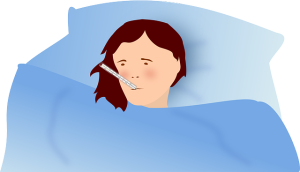by Sean Manning, DC – ICPA.org:
The purpose of the immune system is to allow us to live in harmony with our environment. In fact, most of the trillions of foreign cells present within our body coexist peacefully, and in some cases even contribute to our health and well-being. In spite of this, chronic diseases such as allergies, asthma, and eczema, which were rare several decades ago, have risen exponentially, especially in children, quadrupling during the last two decades.
The number of asthma sufferers in the United States is expected to double by the year 2020, affecting 1 in every 14 people and outnumbering the combined projected populations of New York and New Jersey. A growing number of scientists now believe that the routine measures taken to suppress and prevent infections actually weaken certain responses of a child’s immune system, allowing other less appropriate responses to operate without control. The reduction of childhood diseases has been heralded as one of medicine’s finest accomplishments, yet there are growing suspicions that infection intervention may be having an adverse effect; as childhood infections have decreased, chronic afflictions have increased.
The immune system has two different aspects: the cell-mediated immune system and the humoral immune system. The cell-mediated immune system involves white blood cells and specialized immune cells which “eat” antigens, or foreign particles in the body. This helps drive the antigens out of the body causing symptoms such as skin rashes and the discharge of pus and mucous from the throat and lungs. The cell-mediated response is associated with the beneficial acute inflammatory illnesses of children, and represents the externalization, or driving out of the infection.
The other aspect is called the humoral immune system whereby antibodies—special defense proteins—are produced to recognize and neutralize the antigen. It is a persistent humoral response that is associated with chronic allergic-type diseases.
In order to be healthy, a child must keep a balance between the cell-mediated system and the humoral system, with the cell-mediated system predominating. The cell-mediated response is activated by the natural exposure to bacteria and viruses, in the way children are exposed by interacting with their friends. Through repeated exposure to infectious organisms a child develops a diverse repertoire of immune response patterns. It is the cellmediated response that protects a child from future illness, and develops the type of immune response we commonly associate with life-long immunity. The cell-mediated system suppresses the activity of the humoral system. The more active the cell-mediated activity is, the less active the humoral system is.
However, if the cell-mediated system is not properly stimulated it does not fully develop, leading to an abnormally high production of humoral system antibodies. A humoral system that is continually engaged will overdevelop, creating a hypersensitive environment. When infants are exposed to germs early, their immune systems are pushed to go in an “infection-fighting direction.” Without this push, the immune system’s shift to infection fighting is delayed, and it becomes more likely to overreact to allergens—dust, mold, and other environmental factors that most people can tolerate.
Early life experiences are believed to play a crucial role in the formation and patterning of a child’s immune system. Sensitization begins in utero and the first few months of life are crucial, for once cell-mediated/humoral imbalance occurs it tends to persist until specific measures are taken to shift the immune system back to equilibrium. There are several ways that pattern the reaction of the immune system toward either the cell-mediated response or the humoral response based on their timing and frequency. The important thing for a parent to understand is that their child’s immune system will react based on the way it has been patterned and programmed to react. If your child’s current immune capacity is poor, then it is possible to improve it by making better choices in the future.
Hygiene
There are numerous reports that suggest the excessive cleanliness practiced in modern society may be partly responsible for the increased incidence of allergic diseases. Repeated exposure while young to various types of bacteria and spores found in dirt, dust, and animal dander may actually protect against the development of allergies. A molecule known as an endotoxin naturally occurs in the outer membrane of bacteria. When the bacteria die the endotoxin is released into the environment. Children are exposed to these endotoxins by breathing them in, or by ingesting them when they put their hands or other objects into their mouths. The exposure to bacteria, viruses, and endotoxins is essential for the maturation of the immune system; less exposure leads to imbalanced immune responses.
Children’s early exposure to allergens and infections prime their immune systems to resist them later on. Although children in daycare seem to get sick more often than other children do, this is not necessarily a bad thing. These colds and other infections may be giving their immature immune systems a health workout, resulting in a lower incidence of asthma. Children with the highest degree of personal hygiene are the most likely to develop eczema and wheezing between the ages of two and a half and three and a half years. In 2000, a study of 61 infants between the ages of 9–24 months found that the more house dust an infant was exposed to, the less likely that they would suffer allergies.
Antibiotics
Antibiotics given in the first year of life quadruple a child’s risk of developing asthma. Children given antibiotics after age one year are still one and a half times more likely to develop asthma than children not given antibiotics. What is particularly concerning is that every course of antibiotic treatments a child increases the occurrence of allergies and that treatment with broad spectrum antibiotics, such as streptomycin, tetracycline, and Cipro®, appear to be more likely to be associated with allergy development than is ordinary penicillin.
Antibiotics enhance allergic reactions by sidestepping the normal immune system response. Whenever the immune system successfully deals with an infection it emerges from the experience stronger and better able to confront similar threats in the future. Through the process of developing and then conquering infection, the child gets rid of acquired toxins and poisons from the body and receives a boost to the immune system. If you always jump in with antibiotics at the first sign of infection you do not give the immune system a chance to grow stronger.
Antibiotics also act nonspecifically, killing infectious bacteria as well as upsetting the normal gut flora. Substances that are introduced through the mouth are normally ignored by the humoral system. But, in order for this to occur, the normal bacteria in the intestines need to be present. Alterations in the normal intestinal bacteria levels, especially in infancy, allow food proteins and other particles to pass into the blood stream before they are broken down, where the body identifies them as a threat, contributing to a persistent humoral response and the development of allergic diseases.
Vaccination
Most childhood infections are caused by viruses, and thus do not respond to antibiotics, hence the development of our current vaccine program. Infections contracted naturally are ordinarily filtered through a series of immune system defenses. Naturally-contracted viral diseases stimulate a cell-mediated response, and it appears that because of this, early viral infections are protective against allergic diseases. When a vaccine is injected directly into the blood stream, it gains access to all of the major tissues and organs of the body without the body’s normal advantage of a total immune response. This results in only partial immunity, consequently the need for “booster” shots. Vaccines stimulate a humoral response so their contents are never discharged from the body, the way they would be if the disease were naturally contracted, leaving the body in a chronic state of sensitization. In a study of 448 children, 243 had been vaccinated against whooping cough. Of these, 10% had asthma compared to less than 2% of the 205 children in the non-vaccinated group, suggesting that the pertussis vaccination can increase the risk of developing asthma by more than five times.
Dietary Fat Consumption
Chicken nuggets, potato chips, and other fried foods, while convenient for parents, are relegating their children’s immune systems to behave badly. Another factor that has been identified as a contributor to the rise in allergic diseases is the increased consumption of omega-6 fatty acids and the decreased consumption of omega-3 fatty acids. It has been known for many years that individuals with allergic conditions have disproportionately high levels of omega- 6 fatty acids in their blood. Omega-6 fatty acids actually suppress the immune system and promote inflammation, and allergic responses are, by their very nature, inflammatory. Sources of omega-6 fatty acids are corn, cotton, soybean, peanut, safflower, and sunflower. Omega-6 fatty acids are also present in most animal products.
Inversely, omega-3 fatty acids are known to enhance immunity, reduce inflammation, and protect the nervous system. Dietary omega-3 fatty acids have well documented immunological effects. Sources are flax, hemp, walnut, and cold water fatty fish, especially salmon. It is important to note though that the plant sources of omega-3 fatty acids are inadequate for infants and thus offer minimal benefit early in life. One study showed that children who regularly consumed oily fish were 74% less likely to develop asthma. Other studies show that fish oil supplementation is associated with improved asthma symptoms and reduced medication usage. The immune benefits of omega-3 fatty acids are likely greater during the critical stages of early immune development before the allergic responses are established, so it is recommended that women monitor their fatty acid intake during pregnancy and continue to do while nursing. Once the child is old enough there are omega-3 products designed specifically for children.
Subluxation
The focus of science has shifted from separate entities of the immune system and nervous system to an interactive immunology model. It is now understood that there is an intimate connection between the nervous system and the immune system, and that neurotransmitters can influence the activities of the immune system. In fact, nerve fibers physically link the nervous system and the immune system and there is a constant traffic of information that goes back and forth between the brain and the immune system.
The sympathetic division of the nervous system is the part of the nervous system that reacts to stress. It is the “fight or flight” control center. The sympathetic division of the nervous system also regulates all aspects of immune function, and abnormal activity of the sympathetic nervous system contributes to the cause of conditions where a selection of humoral versus the cell-mediated response plays a role, including allergic reactions.
Spinal movement influences the sympathetic nervous system. Changes to the relative position or movement in the spine interfere with the sympathetic nervous system causing the release of stress hormones and altering immune cell function. The result is suppression of the cell-mediated immune response, and in its absence an increase of the humoral response.
Early stress and trauma is believed to play a profound role in the development of spinal dysfunction, or subluxation, causing immune imbalance. In his research, Gottfried Guttman M.D., found that spinal injury was present in more than 80% of the infants he examined shortly after birth, causing interference in sympathetic function. Tissue injury to the spine and surrounding soft tissue results in scar tissue deposition in the muscles, tendons, ligaments, and joints. This leads to decreased motion in the joints and surrounding tissues. Neurologic changes accompany the spinal insult. This leads to chemical changes and a general shift in the body to the stress response or the “fight or flight” response. Subluxation in the infant and child has been associated with stress experienced at birth, particularly as the result of interventions, and early falls or other traumas.
Restoring proper function to the spine through chiropractic adjustments removes the interference in the nervous system shifting the body away from the sympathetic “alarm” response allowing the immune system to regain equilibrium and reducing hypersensitive reactions. In one study, 81 children under chiropractic care took part in a self-reported asthma impairment study. The children were assessed before and two months after chiropractic care using an asthma impairment questionnaire. Significantly lower impairment rating scores (improvement) was reported for 90.1% of subjects 60 days after chiropractic care in comparison to their pre-chiropractic scores. In addition, 30.9% of the children decreased their dosage of medication by an average of 66.5% while under chiropractic care. Twenty-four of the patients who reported asthma attacks 30-days prior to the study had significantly decreased attacks by an average of 44.9%.
Our children are born with an immune system that is capable of operating against anything that threatens it. Our role as parents should be to support the natural responses of their body in every way that we can; in some cases, that means giving the body a chance to overcome an infection on its own with out antibiotics. In another case, it means providing the proper nutrients to restore inner balance. Most importantly, it means realizing that when a child’s nervous system has interference, the body still knows what it is supposed to do, but is simply unable to do it. Let’s start by removing the interference from the body and then getting out of its way—appreciating that the fever and congestion and vomiting are all part of the miracle that is our child’s immune system working properly, not a sign that their body is failing. The less we focus on the eradication of germs and the more emphasis we place on creating a strong, balanced body, free of subluxation, the better off our children will be.
Article originally posted at ICPA.org.






